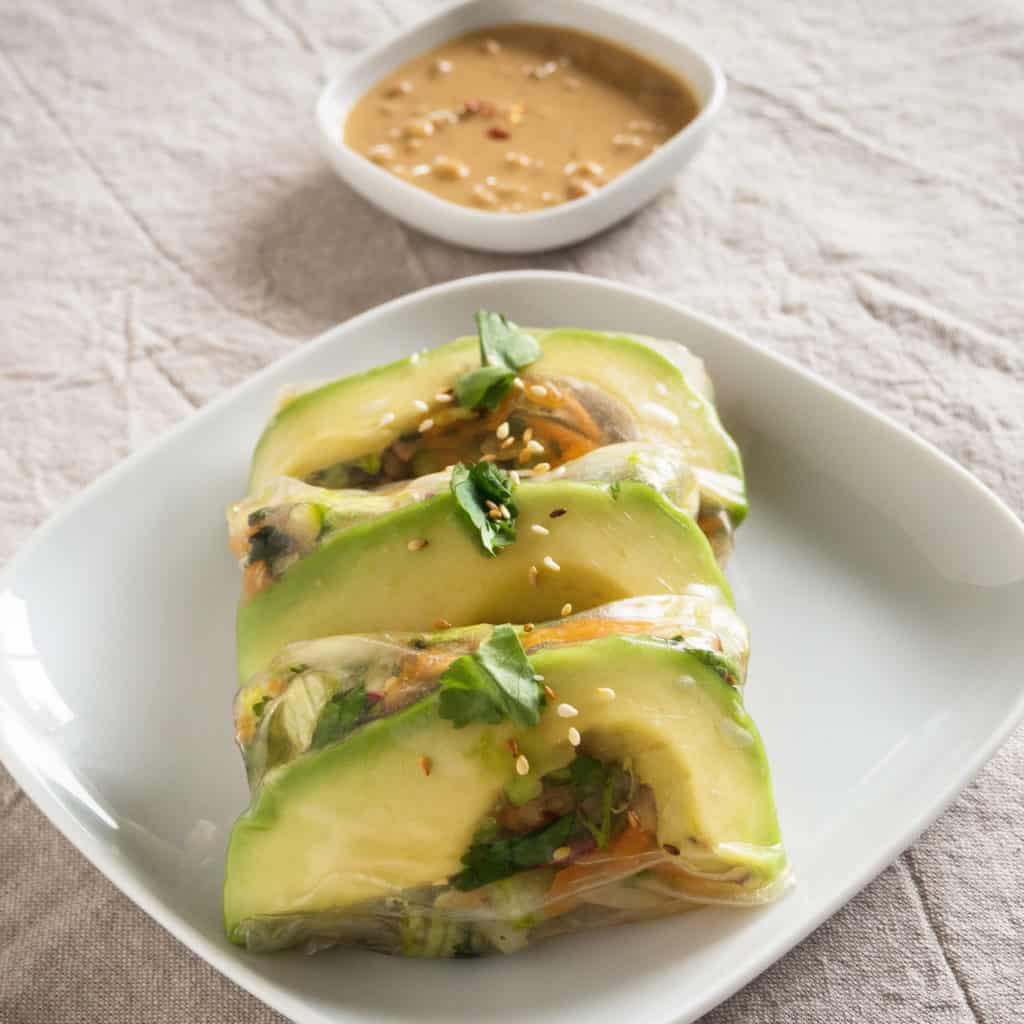
I adore Vietnamese Summer Rolls. They are one of my favourite summer dinners. One summer I think we ate them several times a week all summer and still did not get fed-up with them. They are the ultimate summer weekend lunch or dinner. I love to bring the filling to the table with the wrappers and a bowl of water so everyone can get stuck in and make their own (and often misjudge the filling – always too much!!!).
You can use whatever vegetables you like in Vietnamese Summer Rolls and adjust the spicing if you don’t like the heat of the chilli (you can use a pinch of white pepper instead). I often add tofu instead of avocado. Thai basil is almost aniseed in flavour – if you cannot get Thai basil just leave it out.
Vietnamese Summer Rolls are easy and quick to make.
You can find the full Vietnamese Summer Rolls recipe here.
Perfect for lunch, dinner or fantastic for a picnic or a packed lunch Vietnamese Summer Rolls are the ultimate in versatile and adaptable. The Vietnamese Summer Rolls go great with a simple salad such as Cabbage and Carrot Salad.
Rice paper wrapper are available from Oriental supermarkets (super cheap) and online. They are made from 100% rice and great value for money. To use them they are soaked in luke-warm water for seconds and they become pliable.
I always remove the watery, seed-filled centre from cucumbers. They taste better that way and your dish will not be diluted by the water from the centre of the cucumber.
Preparation
Difficulty easy
Preparation time 15 minutes
Cooking time 0 minutes
You can find the full Vietnamese Summer Rolls recipe here.
Allergens
Vietnamese Summer Rolls are gluten-free and vegan as well as…
Celery free
Coconut free
Garlic free
Lupin free
Mustard free
Nightshade free*
Onion free
Sesame free*
Tree nut free
*For nightshade free leave out the chilli (or replace with a pinch of white pepper).
*For sesame free leave out the sesame seeds.
About
Vietnamese cuisine has become increasingly popular in the UK in recent years with chains such as Pho springing up (vegan and gluten-free friendly). Many years ago my favourite restaurant (bring-your-own cafe) was in Hackney in east London. It was solid in terms of the food and great value for money and so we used to go there several times a week sometimes. That was in the days before I stopped eating gluten, among other things.
However Vietnamese food is surprisingly gluten-free friendly. Soya sauce use tends to be limited to the north of the country where there is a strong Chinese influence and wheat flour is not commonly used. However, traditional and popular Vietnamese food is not vegetarian or vegan friendly. Vietnamese cuisine has a passion for fish sauce nuoc mam, which is shared with the entire region, that infiltrates almost every dish as a seasoning. Nuoc mam is difficult to avoid and it is even more difficult to explain that you don’t want to eat it. I visited Thailand many years ago and it was almost impossible to explain I wanted a dish without fish sauce. I had a similar issue in Spain with ham (jamon is life!). Some food is so deeply ingrained in a culture it is difficult to rationalise not eating it. There is also a very strong French influence in Vietnam most noticeable in the use of baguette in street food such as bánh mì.
Summer rolls or goi cuon are wonderful translucent parcels traditionally packed with salad, pork or seafood (or both) and coriander, before being neatly rolled and served with a peanut dip. My version is gluten-free, vegan and delicious.
The key component to summer rolls or goi cuon is rice paper. In Vietnam the rice paper is called bánh tráng or bánh đa nem. The wraps are usually made from rice, salt, and water but can also include tapioca flour. Tapioca powder is sometimes added to make the rice paper glutinous and smooth. The factory-made sheets are usually sold as dried thin, crisp, translucent, round sheets that are wrapped in cellophane. In Vietnam some rice paper is still made by hand – and a premium is charged for this skilled craft. To make rice paper raw rice is ground with water to a pulp, aged pulp (kind of like a sourdough starter) is added, the dough is spread over a cloth that is stretched over a pot of boiling water and the dough is steamed for 30-45 seconds. The rice paper is transferred to a cooling rack before being dried on a bamboo rack in the hot sun. A fascinating process and not the sort of thing that is easy to do in London (enough sun to dry the rice paper would be a problem).